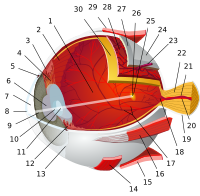Uvea
In fact, it is a partial loan translation of the Ancient Greek term for the choroid, which literally means “covering resembling a grape”.
It is traditionally divided into three areas, from front to back: The prime functions of the uveal tract as a unit are: In addition, some uveal regions have special functions of great importance, including secretion of the aqueous humour by the ciliary processes, control of accommodation (focus) by the ciliary body, and optimisation of retinal illumination by the iris's control over the pupil.
Pharmacological control over pupil size remains an important part of the treatment of some ocular diseases.
Drugs can also reduce the metabolically active process of secreting aqueous humour, which is important in treating both acute and chronic glaucoma.
A rare disease called sympathetic ophthalmia may represent 'cross-reaction' between the uveal and retinal antigens (i.e., the body's inability to distinguish between them, with resulting misdirected inflammatory reactions).
